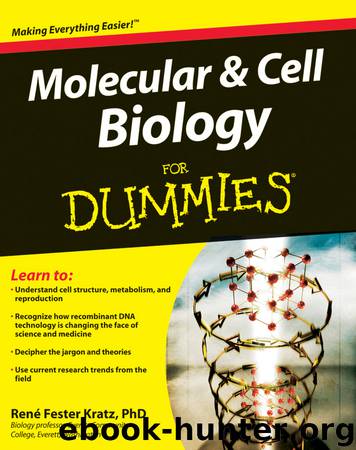Molecular and Cell Biology For Dummies® by Rene Fester Kratz

Author:Rene Fester Kratz
Language: eng
Format: epub
Publisher: Wiley
Published: 2010-03-11T05:00:00+00:00
Doing the math: How many ATP can you make from the energy in a glucose molecule?
The exact number of ATP molecules you’d get for breaking down a glucose molecule through cellular respiration would be pretty hard to actually count, but you can use the following rules to estimate what is theoretically possible:
Every time a pair of electrons from NADH passes through the electron transport chain, ATP synthase gets enough energy to produce approximately three ATP molecules.
Every time a pair of electrons from FADH2 passes through the electron transport chain, ATP synthase gets enough energy to produce approximately two ATP molecules.
In eukaryotes, the NADH produced in the cytoplasm has to cross into the mitochondrion in order to donate electrons to the electron transport chain. Different cell types have different ways of moving this NADH into the mitochondrion, which can require energy comparable to the amount in one ATP molecule.
With these rules, you can count up the products of cellular respiration and calculate the theoretical number of ATP molecules you could produce in cellular respiration from the energy in one glucose molecule:
Two ATP per glucose are produced during glycolysis.
Two ATP per glucose are produced by the Krebs cycle.
Two NADH per glucose are produced during glycolysis. If it costs one ATP to move these into the mitochondrion, then they’re worth only two ATP each (2 × 2 = 4 ATP for these NADH).
Two FADH2 per glucose are produced by the Krebs cycle. The FADH2 molecules are worth two ATP each, so 2 × 2 = 4 ATP for these FADH2.
Eight NADH per glucose are produced by pyruvate oxidation and the Krebs cycle. The NADH molecules are worth three ATP each, so 8 × 3 = 24 ATP for these NADH.
When you add up all the ATP molecules, that is 2 + 2 + 4 + 4 + 24 = 36 ATP per glucose. Because some cells, such as bacterial cells, don’t have to “pay” to transport NADH from the cytoplasm to the mitochondrion, these cells would get 2 more ATP. So, the theoretical max for the number of ATP per glucose molecule that is complete oxidized during cellular respiration is 36 – 38 ATP.
Breaking Down Complex Carbohydrates, Proteins, and Fats
In order for food molecules besides glucose to be broken down in cellular respiration, enzymes need to change the food molecules into intermediates in glycolysis or the Krebs cycle. Once the food molecules become intermediates in these pathways, they will be oxidized and their energy will be transferred to ATP.
Finding an on-ramp to the superhighway
Cellular metabolism consists of hundreds of chemical reactions that interconnect to make a vast network. The product of one pathway may be a reactant or an intermediate in another. The molecules that move through this metabolic network are like little cars driving along the freeway. They can go down one freeway for a long time, or they can exit a freeway and move onto another one just like a molecule can exit one pathway and get picked up by another.
Download
This site does not store any files on its server. We only index and link to content provided by other sites. Please contact the content providers to delete copyright contents if any and email us, we'll remove relevant links or contents immediately.
Sapiens: A Brief History of Humankind by Yuval Noah Harari(13035)
The Tidewater Tales by John Barth(12024)
Do No Harm Stories of Life, Death and Brain Surgery by Henry Marsh(6331)
Mastermind: How to Think Like Sherlock Holmes by Maria Konnikova(6217)
The Thirst by Nesbo Jo(5775)
Why We Sleep: Unlocking the Power of Sleep and Dreams by Matthew Walker(5633)
Sapiens by Yuval Noah Harari(4526)
Life 3.0: Being Human in the Age of Artificial Intelligence by Tegmark Max(4490)
The Longevity Diet by Valter Longo(4439)
The Rules Do Not Apply by Ariel Levy(3896)
The Immortal Life of Henrietta Lacks by Rebecca Skloot(3816)
The Body: A Guide for Occupants by Bill Bryson(3786)
Why We Sleep by Matthew Walker(3765)
Animal Frequency by Melissa Alvarez(3748)
Yoga Anatomy by Kaminoff Leslie(3696)
Barron's AP Biology by Goldberg M.S. Deborah T(3624)
The Hacking of the American Mind by Robert H. Lustig(3572)
All Creatures Great and Small by James Herriot(3506)
Yoga Anatomy by Leslie Kaminoff & Amy Matthews(3389)
